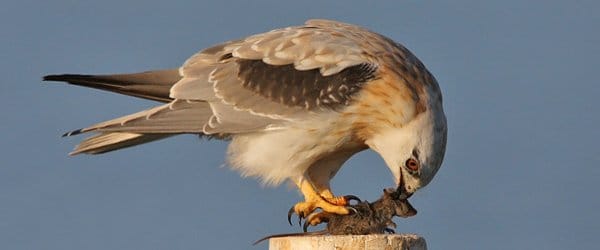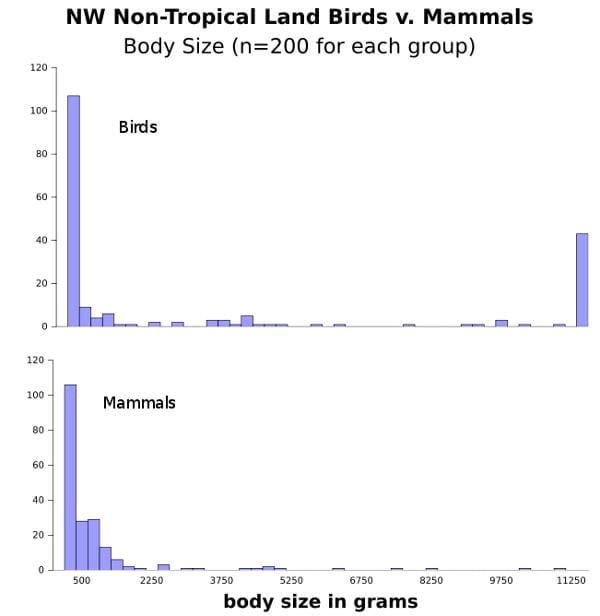I was looking out a car window the other day and noticed that of all the wildlife most of it was bird. I’m sure there was a lot of insect in range of my eyeballs, hiding behind leaves or camouflaged against bark as insects are wont to do. A squirrel skittered by … a squirrel is not a bird. But it happened at that moment that a lot of what I was looking at was avian in nature: a few crows, some sparrows, blackbirds, and other run of the mill inner-ring suburb fliers and flitterers.
Then a thought occurred to me. I once knew a professor for whom I substituted when he was ill. He had the habit of asking very similar question about the animals featured in his zoology lectures, including basic questions like how big they are, what limits physiology puts on their geographic range, etc. Ironically, when I looked out the window that day I could also see this very self same professor, long retired, walking back towards his house at a shuffle while the birds mostly ignored him, as the whole scene faded into the distance as the car I was in drove away.
Photograph by Paul Randall (wingsonwire.com)
So the thought occurred to me that there is a lot of bird on the landscape, in terms of numbers of individuals as well as sheer biomass. It made me think that birdwatchers are loafing. Watching birds isn’t much of a challenge if you can’t swing a dead cat without hitting one. Try watching fossorial Insectivores for a while, see how that goes! But of course, I do understand that bird watchers strive to see the birds that are at the lower end of the distribution of abundance, or to observe unusual behavior, so in a sense all this other bird-biomass out there consisting as it does of mundane birds is a distraction rather than an objective. But still, how much bird is there?
It turns out to be pretty hard to find straight forward numbers to address this question, and obviously it varies by habitat. For instance, among animals, booby and noddy combined probably represents the majority of the biomass of the somewhat unusual St. Peter and St. Paul islands, studied by Darwin. In your back yard, if you have a feeder and exclude insects, birds may represent 100% of the animal biomass until either you our your cat walks outside. But if you look at a bit of prairie in South Dakota during the dead of winter, you may see very few birds and a lot of bison.
Here’s some data from the famous research project of Manu, Peru, giving biomass in kilograms per hectare. The data here are from the site of Manaus:
All animals: 200
Mammals: 8.4
Birds 3.4
Amphibian’s and Reptiles: 3.4
Insects and other creatures that live in the soil, all other insects, and spiders: 184.1
As one would expect, the cryptic and the creep-crawly dominate, and that’s not even including microbes. But if we look at the numbers only of things you would see as a nature lover or bird watcher who had not just turned over a stone or done a face-plant in the mud, it is interesting to note that birds and amphibians/reptiles are about the same, and mammals are double in biommass of either, even though if you were there in the Peruvian Jungle you’d see mainly the birds. This is partly because birds are by and large in the business of being seen; This is part of their social system and they tend to be diurnal, plus of course they fly. This is also because mammals are large. A single large spider monkey, which might be out of view, equals a large number of lightly built and small birds which may be scattered across the landscape. A little bit of bird biomass goes a long way.
From this we can conclude that even though it looks like there are a lot of birds on the landscape compared to mammals or other vertebrates, or to animals in general, this is a function of bias in what we manage to observe, which is in turn affected by the inherent visibility of diurnal flight, color and song mediated social behavior, and the cryptic nature of non-bird things that are either small or nocturnal.
I do not assume that Manaus is fully representative of the planet earth, and I already pointed out St. Paul and St. Peter islands. There are probably other major trends that depend, for example, on latitude and timing. The clifftop habitats along rocky shores of the North Atlantic (on both sides of the pond) abound in bird biomass during breeding bouts, for instance. When Albatross alight in temporal alignment anything else is swamped out. Starlings secreting their nests on steel beams below elevated streets in urban environments seem myriad. But on average, across the globe, I’d bet dollars to donuts (and I like donuts) that mammalian biomass generally outweighs that of birds. One muskox on a tundra of flocking phalaropes is more than enough to beef up the mammalian count of kilograms.
This brings up a second question that is very relevant to this discussion: How big are birds? Birders know a lot about how big birds are because this is how we identify them, in part. But what I mean here is, how big are birds relative to other vertebrates? Comparing mammals, birds, and reptiles, for instance, what is the distribution and range of sizes?
This is also a hard question to address because most data on animal size distribution does not compare across classes of animals, and/or focuses on groups that would not be helpful. For instance, I can lay my hands on data for primates and rodents (because I’ve collected those data for research) but I don’t have comparable data for bovids (just selected data) and zero data for birds (in spreadsheets on my computer).
To remedy this, I visited the Animal Diversity Web site at the University of Michigan. Here one is able to query a large, fairly complete, and reasonably accurate database of animal life. There are limitations to the search engine, and these data are not verified, but it is a start. I queried for birds and mammals living in the new world (but excluding sea birds) outside of the tropics (which includes a lot of tropical migratory birds, obviously) an a similar sample of mammals. There are 200 animals in each sample, and I presume that this is a random subset of the larger sample of over 400 or so in each category. (That presumption may be wrong but I don’t think it matters for the present use of the data.)
The following histogram shows the results. The top histogram is mammals, the bottom one birds. The largest bird, forming the short bar on the right of the bird histogram, is a swan. Note that there are a lot of mammals (about 40) that are bigger than any bird in this sample. This is not a surprise. What is more interesting, however, is what is going on at the left (smaller) size of the histogram. Here, we see that mammals have a narrower distribution of size at the low end while birds have more size diversity. If we were to remove the hooved animals and non-Mustelidae carnivores (i.e., remove the wolves, keep in the minks) for the mammal data set, most of the animals on the right side of the mammal graph would go away and we would have this interesting difference in size distribution whereby birds would be robustly distributed across the first couple of kilograms of body size, while mammals would be heavily concentrated in the few-hundred-gram range. Those mammals consist of the previously mentioned fossorial members of Insectivora, Rodents, and bats.
The reason this is interesting is this: If you have two groups of animal types living in the same habitat, they usually differentiate themselves by either timing or some key relationship to the ecology which is usually (though not always) reflected in body size. If birds and mammals were broadly similar … and they are in that they are terrestrial vertebrates, but they are not in other ways … then we might expect to see similar body size ranges but one being more nocturnal as a group, and the other more diurnal. Or, we might expect to see them all be diurnal or nocturnal (as groups) but differentiate in body size. What we see here, however, is both: Most of the mammals at this small end of the graph are nocturnal, and there is clearly a lack of overlap in body size for many species.
None of which means much without a lot more consideration to what is being compared here, including the difficulties of comparing one group that both flies (bats) and does not (mainly rodents) with one that mostly flies (birds); one group that is mostly quadrupedal (except the kangaroo type rats) with one that is bipedal; and one group that lays external eggs to incubate (birds) with one that bears live young (mammals); And so on.
What can be said is that among the vertebrates we see around us as we go on our birdwatching expeditions and nature walks, or visits to the retired professor, is this: Above a certain size, birds are small, numerous, and evenly distributed compared to mammals, while below a certain size mammals are small and hiding in the dark compared to birds.
Sources
Laden, Greg. 2011. Where the abyss touches the sky: A Booby and Noddy ecosystem. Birdingblogs.com
Leigh, Egbert Giles. 1999. Tropical Forest Ecology: a view from Barro Colorado Island. Oxford University Press.
Myers, P., R. Espinosa, C. S. Parr, T. Jones, G. S. Hammond, and T. A. Dewey. 2006. The Animal Diversity Web (online). Accessed July 12, 2011 at http://animaldiversity.org.















Of all the things there are to love about birds, I think Visibility is number one. I could love wild cats and canids, and do…but I’ve seen five bobcats in my life and about a dozen wolves, and I’ve seen hundreds of thousands of birds. Birds are generous; birds are kind to the observer and student. It’s a no-brainer to love and study birds as a lifelong passion. Thanks for this cool post, Greg. And thanks for the help on the sandhill crane front. It is appreciated.
Yes, visibility is clearly the deciding factor. And the fact that most of the mammals in an area are “LBJs” – lousy brown jobs. Mice, shrews, bats. It is indicative of the visual factor that all birders will tell you they prefer birds over mammals, but that any mammal encounter will be highly valued by these same birders. Here in Germany, I can easily have a 150 bird species day at the coast, seeing several 10,000 individuals, but a mammal day beyond 5 species and 10 individuals will be very unusual.
Having said that, it is an interesting and intriguing thought that without birds, we would likely see many more mammal species in different body size classes and they’d be less nocturnal.
Hmmm, a 150 mammal species day?
Nah, I’ll go with the birds. 😉
In may area, most of the bird mass seem to be the starlings and little brown birds brought over by that Shakespearian obsessed guy. The next most common bird are vultures and hawks. I see the occasional crow and raven, and quite a few gulls, hummers (four kinds) and turkeys. We used to see more quail around here, but feral cats are driving them extinct. Too bad so many people are not responsible pet owners, the quails are very cute to watch.